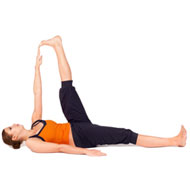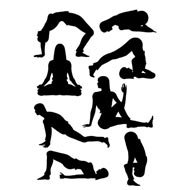- Raja yoga
- Yoga Stretches
- Jivamukti Yoga Poses
- Yoga Tree Pose
- Sun and Moon Yoga
- Wind Removing Pose
- Hare Pose
- Accomplished Pose
- Urdhva Mukha Pinch Mayurasana
- Revolved Abdomen Pose
- Raised Foot Pose
- Scorpion Pose
- Butterfly Pose
- Half Tortoise Pose
- Revolved Twist
- Balancing Stick Pose
- Cat Pose
- Supported Shoulderstand
- Crane Pose
- Handstand
- Happy Baby Pose
- Firefly Pose
- Scale Pose
- Side Plank Pose
- Upward Facing Two-Foot Staff Pose
- Stick Pose
- Revolved Head-to-Knee Pose
- Full Boat Pose
- Upward Extended Feet Pose
- Yoga arm balance poses
- Core Yoga
- Inversion Yoga Poses
- Seated And Twist Yoga
- Horse Pose
- Cobbler Pose
- Seated Wide Angle Pose
- The Compass Pose
- Half Crow Pose
- Bound Half Moon Pose
- Lotus Pose
- Reverse Warrior Pose
- Fixed Firm Pose
- Back-bend Poses
- Forward bend Poses
- Sarvangasana
- Ashtanga Yoga Poses
- Warm up poses
- Seated Poses
- Seated Forward Bends
- Chair Poses
- Standing Poses
- Standing Balancing poses
- Yoga Asanas
- Hatha Yoga Asanas
- Yoga Postures Online
- Partner Yoga Poses
- Anusara Yoga Poses
- Advanced Yoga poses
- Restorative Yoga Poses
- Kids Yoga Poses
- Beginning Yoga Postures
Reclining Big Toe Pose (Supta Padangusthasana)
The practice of yoga for health benefits dates back to ancient India. Since then, yoga has helped people lead a healthy life, free from ailments.
Yoga comprises of breathing practices, physical exercises, and meditation and relaxation techniques.
Out of several poses in yoga, one is the Reclining Big Toe Pose (Supta Padangusthasana) that is very easy to perform and very effective when it comes to improving the health of your back and spine.
Reclining big toe pose
Derived from its Sanskrit name (Supta = lie down + Pada= leg/foot + Angushtha= big toe + Asana = pose), this pose is the key to open and stretch your legs to the fullest. Many people perform this yoga posture unknowingly, without knowing the name, as a stretching exercise. The Reclined Big Toe Pose helps in improving both the mental as well as physical health of the practitioner. Enumerated below are the steps involved in order to perform the pose.
Steps
- The first step involves lying flat on the floor with your legs extended outwards. You can place a folded blanket under your head to make it more comfortable. Now, exhale and bend your left knee, and move your thigh further into your upper body so that you can hug it. Keep in mind that you need to keep your right leg straight and pushed downward toward the floor.
- Take a yoga strap, and place it across the arch of your left foot. You need to hold this strap with both your hands firmly. Next, begin straightening your knee while inhaling at the same time. In other words, move your left heel toward the ceiling as you pull on the strap. Next, move your hands along the strap such that your elbows are straight. The idea is to take your hands as high as possible. Draw your shoulder blades apart as move your hands, while gently pressing them onto the floor. Make sure your collar bones are as wide as possible away from your sternum.
- Extend your left leg higher such that there is a complete extension from your left heel to your sitting bone. Once your left leg is perpendicular to the ground, try and move it nearer to your head so as increase the stretch felt along the back of your leg. Push your left thigh into your pelvis and your left big toe toward to ceiling for a complete stretch.
- Once you are in this position, you can choose between two maneuvers. You can either stay in this stretching position or you can turn your leg outward, away from the hip. Exhale while swinging your left leg outward and try to hold it a couple of inches above the floor. Pin your right thigh on the floor tightly as you do this. Keep rotating the left leg outward and try aligning it with the shoulder joint. Now bring the leg back to the extended stretch position as you exhale and ease the grip on the yoga strap.
- Stay in this position for one to three minutes depending on your choice and comfort. The side position also requires an equal amount of time as the vertical position. After returning to the vertical from the side position, release the grip on the strap and hold the leg in its place for 30 seconds.
Now exhale and slowly bring the leg down. Repeat for the right leg.
Reclining big toe pose steps help to prevent any injury if followed exactly as told, so you should not overlook the smaller details.
Precautions
Following are the Reclining Big Toe Pose precautions for your safety:
- If you are suffering from diarrhea, then you should not practice this pose.
- People suffering from headaches should also refrain from performing the pose.
- Using a folded blanket beneath your head is a must for high blood pressure patients.
Beginner's tip
If your body is stiff, then you can always rest the bottom leg heel against a wall. Another useful thing is to place a block right outside the hip of the raised leg. The use of block is to rest your leg on it when you swing it to the side. The support provided under the thigh softens the inner groin.
Benefits to the body
There are numerous benefits to body parts that this pose offers, albeit they are limited to the lower body. Following are the benefits:
- This pose stretches the calves, hamstrings, hips thighs and the groin.
- This pose increases the strength of the knees.
- It helps in the stimulation of the prostate gland.
Therapeutic applications
The therapeutic applications of reclining big toe pose are as follows:
- People suffering from sciatica can perform this pose to relieve pain.
- Performing this pose can help in improving the digestion.
- Infertility can be helped by practicing this pose.
- Menstrual discomfort and backache can also be managed.
- This pose is a therapy for flat feet and those suffering from high blood pressure.
Variations
Just like the other yoga poses, there are variations for reclining big toe pose as well.
- Instead of swinging the raised leg sideways, swing it in the opposite direction. Exhale as you cross the leg to the opposite side. This makes the pose even more challenging and imparts additional stretching of the leg.
- To make the pose simpler, you could keep the knee of your raised leg slightly bent, till you are able to stretch it fully. However, it is best to start with professional guidance so as to be able to perform these poses correctly and with ease.
Preparatory poses
Since this pose has a deep impact on the body, certain preparatory poses for reclining big toe pose are necessary.
- Downward Facing Dog Pose (Adho Mukha Svanasana)
- Forward Bending Pose(Uttanasana)
- Bound Angle Pose (Baddha Konasana)
Follow up poses
The follow up poses are necessary to relieve and relax the body after the big toe reclining pose. These are mostly restive poses and can include standing poses as well as various seated forward bend poses.



